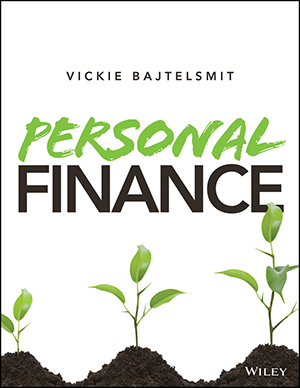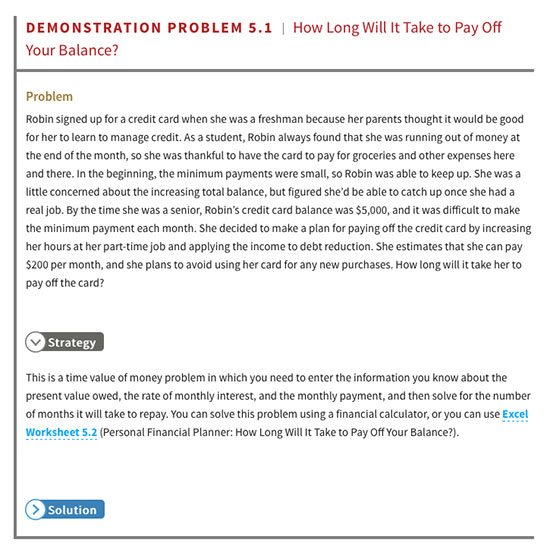
Personal Finance
By Vickie Bajtelsmit
Designed for a one-semester, introductory undergraduate course in personal finance, Personal Finance emphasizes the development of lifelong financial decision-making skills. This course offers significant online content and interaction, which makes it suitable for a traditional face-to-face environment, a completely online class, or a flipped classroom experience.
WileyPLUS for Personal Finance includes ORION Adaptive Practice that helps students build their proficiency on topics and use their study time more effectively.
Schedule a Demo Sign Up for a Test Drive Adopt WileyPLUSWant to learn more about WileyPLUS? Click Here
WileyPLUS facilitates student engagement.
WileyPLUS is a collaborative learning environment that provides immediate insight into strengths and problem areas through a combination of dynamic course materials and visual reports so that both you and your students can act on what’s most important. With WileyPLUS, students make deeper connections as they interact with course material and each other.
Interactive figures improve critical thinking.
Integrated throughout the WileyPLUS E-Text, interactive figures reinforce core concepts and help students see the relevance of the content to their own lives, providing opportunities for learning and critical thinking.

Demonstration problems with video content help improve learning.
Demonstration problems included within each chapter provide step-by-step directions for sample problems. These serve as an easy reference for students to consult when working on homework problems involving financial math. In addition, demonstration problem videos using lightboard technology help students better understand the process of working through these problems.
- Excel Worksheets: The course includes many downloadable Excel Personal Financial Planning worksheets. Many of these are designed to be used by students to develop their own personal financial plan. Instructors who do not require students to use a financial calculator will appreciate the Excel worksheets that have been designed to simplify financial math calculations for students.
- Case Study Applications: Applying personal finance concepts to real-life problems makes the material more “real” for students. Each section includes one or more case examples in which a family or individual faces a personal finance problem such as budgeting, credit management, or saving for a child’s education. The case solutions identify how to use recently presented text content to solve the problem. Although these short cases generally relate to a single learning objective, the assignable cases in the end-of-chapter section are more comprehensive.
- Video Resources: Integrated throughout the E=Text, students and instructors have access to several different types of videos to enhance the learning experience. Videos include narrated PowerPoint™ slides, peer videos, and demonstration problem videos from the author using lightboard technology. In addition, instructors have access to a curated list of real-world videos that align to each chapter.
Features Include:

Vickie Bajtelsmit is a Professor in the Department of Finance and Real Estate at Colorado State University where she has taught a wide variety of undergraduate and graduate classes, including personal finance, financial planning, risk management and insurance, real estate, employee benefits, and investments. She currently serves as the Director of the Master of Finance program and formerly was the Department Chair from 2007-2012. Her educational background includes a Ph.D. in Insurance and Risk Management from the University of Pennsylvania’s Wharton School of Business and a J.D. from Rutgers University School of Law. In addition to her previous personal finance books A Busy Woman’s Guide to Financial Freedom (2001), Personal Finance: Skills for Life (2006), Personal Finance: Managing Your Money and Building Wealth (2008), she has authored numerous articles in academic and professional journals, focused on personal finance issues related to retirement, insurance, investments, and real estate.
Previous professional accomplishments include service as the President of the American Risk and Insurance Association (2010), President of the Risk Theory Society (2010), President of the Academy of Financial Services (2004), and service on the CFP-Board committee that developed the model curriculum for financial planning programs. She currently serves on the national Board of Trustees for the Jump$tart Coalition for Personal Financial Literacy, the Board of Directors for Junior Achievement of Northern Colorado, and participates actively in several Society of Actuaries research groups.
Chapter 1: Financial Planning Process
Chapter 2: Financial Planning Tools: Personal Financial Statements and the Time Value of Money
Chapter 3: Budgeting and Cash Management
Chapter 4: Tax Planning
Chapter 5: Credit
Chapter 6: Making Automobile and Housing Decisions
Chapter 7: Insurance, Cars, and Homes
Chapter 8: Life Insurance and Long-Term Care Planning
Chapter 9: Employee Benefits: Health, Disability, and Retirement Plans
Chapter 10: Saving for Distant Goals: Retirement and Education Funding
Chapter 11: The Fundamentals of Investing
Chapter 12: Investing in Stocks and Bonds
Chapter 13: Investing in Mutual Funds and Real Estate
Chapter 14: Estate Planning

